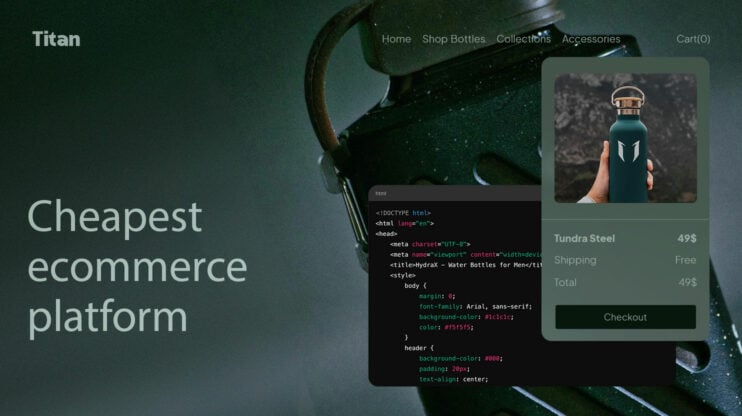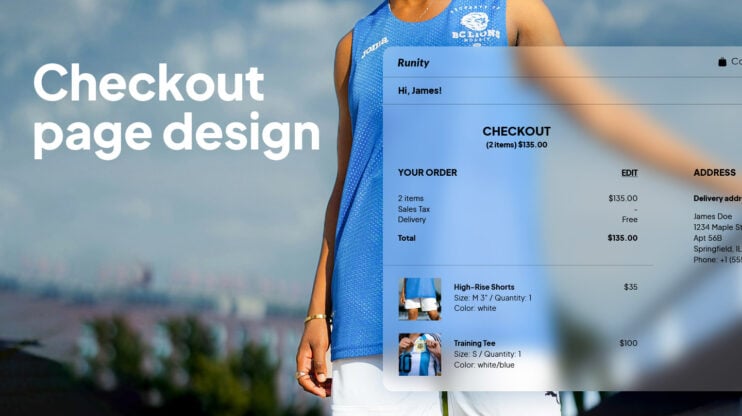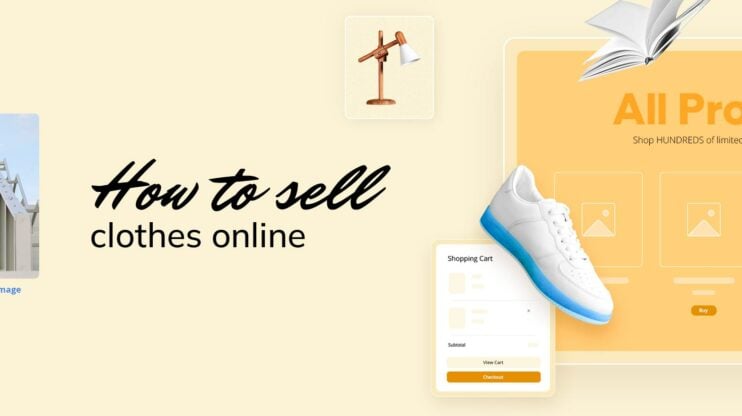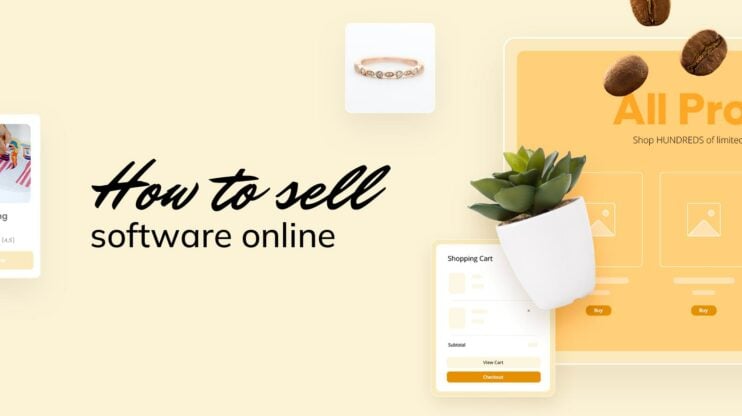B2C ecommerce platforms have changed the way businesses sell products to customers online. These platforms let companies create digital storefronts to reach shoppers directly. They offer tools for product listings, payments, shipping, and more.
The best B2C ecommerce platforms make it easy for businesses of all sizes to start selling online quickly. Choosing the right platform depends on a company’s specific needs and goals. Factors to consider include ease of use, customization options, payment processing, inventory management, and pricing. Some platforms work better for small businesses, while others suit large enterprises. Researching different options helps find the best fit for each unique business.
This article covers the important aspects of choosing and optimizing a B2C ecommerce platform, focusing on essential features, platform comparisons, and best practices in design, marketing, and customer engagement to help businesses succeed in online retail.
FAQ
How to log in to a B2C platform?
What are the top B2C platforms?
Can you list popular B2C platforms?
What are some examples of B2C platforms?
Where can I find reviews of B2C platforms?
What are common B2C ecommerce examples?
What does B2C platform mean?
Which websites are B2C ecommerce?
What is an example of a B2C website?
Is Shopify considered a B2C platform?
Understanding B2C ecommerce platforms
B2C ecommerce platforms are tools that help businesses sell products directly to consumers online. These platforms have changed how people shop and how companies reach customers.
Definition and scope
A B2C ecommerce platform is software that lets businesses create online stores to sell goods or services to individual buyers. It handles tasks like displaying products, processing payments, and managing orders. These platforms range from basic website builders to complex systems for large retailers.
Evolution of online retail
Online shopping has grown a lot since the early days of the internet. At first, only big companies could afford to sell online. Now, even small businesses can easily set up web stores.
Early ecommerce sites were basic and hard to use. Today’s platforms are much better. They offer smooth checkout, mobile-friendly designs, and ways to personalize the shopping experience.
As more people shop on phones and tablets, ecommerce platforms have adapted. They now focus on making sites work well on all devices.
Key characteristics
Good B2C ecommerce platforms share some important features:
- Easy to use: They let businesses set up and manage stores without needing to know how to code.
- Secure: They protect customer data and offer safe ways to pay.
- Flexible: They can grow with a business and add new features as needed.
- Connected: They work with other business tools like accounting software.
Many platforms also offer marketing tools to help businesses reach more customers. This can include email campaigns, social media links, and ways to show up in search results.
Pricing is another key factor. Some platforms charge monthly fees, while others take a cut of each sale. Businesses need to pick a platform that fits their budget and sales volume.
Key features of B2C ecommerce platforms
B2C ecommerce platforms come with features that make online shopping easy and fun for customers. These tools help businesses sell products and keep shoppers happy.
User-friendly interfaces
A good B2C ecommerce platform has a simple design that’s easy to use. The home page shows popular items and deals. Menus help shoppers find what they want fast. Product pages have clear pictures, prices, and details. The shopping cart is easy to see and use. Checkout is quick, with few steps.
Search bars let customers find items by typing words. Filters narrow down choices by things like price or color. Many platforms use AI to suggest products based on what shoppers like. This makes finding new things more fun.
Mobile optimization
More people shop on phones now, so mobile-friendly design is a must. Good platforms make sites look great on small screens. Buttons are big enough to tap. Pages load fast, even on slow connections. Text is easy to read without zooming.
Many platforms offer apps for iOS and Android. These apps can send sale alerts to phones. They might use the camera to let shoppers “try on” items virtually. Some apps work offline, so customers can browse even without the internet. Mobile pay options like Apple Pay make checkout super fast on phones.
API integration
Modern B2C ecommerce platforms often come with robust API integration capabilities. This allows businesses to seamlessly connect their store with various external systems such as CRMs, inventory management, and customer support tools. With API integrations, platforms can offer a more cohesive experience, pulling in data for a unified view of operations and enhancing features with third-party services.
Google Analytics integration
Understanding customer behavior is key to optimizing an ecommerce store. Integration with Google Analytics provides insights into how shoppers interact with the website, from product views to checkout drop-offs. Businesses can track conversion rates, measure the success of marketing campaigns, and make data-driven decisions to improve the shopping experience and drive sales.
UI/UX design enhancements
Platforms that prioritize UI/UX design foster a better customer experience. By focusing on smooth navigation, visually appealing layouts, and intuitive interactions, they keep users engaged. UX-enhancing features like dynamic product displays, easy-to-use filters, and well-placed calls to action guide customers smoothly through their shopping journey, boosting satisfaction and conversion rates.
Backend infrastructure
A reliable backend infrastructure ensures that the platform can handle high traffic volumes, manage large inventories, and support real-time updates. A strong backend enhances performance, minimizing downtime and maintaining fast load speeds even during peak shopping times. Secure and scalable backend systems help businesses grow without disruption.
Checkout and payment infrastructure
An efficient checkout and payment infrastructure is crucial for a seamless purchase experience. B2C ecommerce platforms support multiple payment methods, including credit cards, digital wallets, and even buy-now-pay-later options. They offer secure payment processing, fraud protection, and PCI compliance, ensuring customers can complete purchases quickly and confidently. A smooth checkout process reduces cart abandonment and increases conversion rates.

Create your online store in minutes!
Looking to sell online? Develop and launch your store with 10Web AI Ecommerce Website Builder.
Security and compliance in B2C ecommerce platforms
Online stores need strong safety measures to protect customer data and payments. Good platforms offer tools to keep information safe and follow rules.
Data protection measures
B2C ecommerce platforms use several methods to protect customer info. They encrypt data to make it unreadable if stolen. Many use firewalls to block unauthorized access. Regular security updates patch vulnerabilities.
Some platforms offer two-factor authentication. This adds an extra step when logging in. Users enter a code sent to their phone or email. It makes it harder for hackers to break in.
Backups are important too. They save customer data and order history. If something goes wrong, the store can restore lost info.
Payment security
Safe payments are key for online stores. Most B2C ecommerce platforms use secure payment gateways. These encrypt credit card details during transactions. They also follow PCI DSS rules for handling payment data.
Many offer fraud detection tools. These look for suspicious activity like unusual spending patterns. Some use address verification to check if billing and shipping addresses match.
SSL certificates are standard. They create a secure connection between the customer’s browser and the store’s server. This protects data as it travels over the internet.
Building a B2C ecommerce website
Creating an online store involves several key steps and considerations. From selecting the right platform to implementing security measures, each element plays a crucial role in the success of your ecommerce venture.
Choosing the right platform
Picking a suitable ecommerce platform is the first step in building your online store. Popular options include 10Web, Shopify,and BigCommerce. Each platform has its strengths and weaknesses, which will be discussed later in the article.
Consider your budget, technical skills, and business needs when making your choice. Some platforms charge monthly fees, while others take a percentage of sales. Think about the long-term costs and benefits before deciding.

Create your online store in minutes!
Looking to sell online? Develop and launch your store with 10Web AI Ecommerce Website Builder.
Website design considerations
Your website’s design can make or break your online store. It needs to look good and be easy to use. A clean, simple layout often works best. Make sure your site loads quickly and works well on mobile devices.
Use high-quality images of your products. Write clear, easy-to-read product descriptions. Make your contact information easy to find. Include customer reviews to build trust.
Your site’s navigation should be simple and logical. Customers should be able to find what they’re looking for in just a few clicks. Use categories and filters to help shoppers browse your products.
Product catalog management
Organizing your product catalog is key to a good shopping experience. Group similar items together and use tags to make products easy to find. Keep your inventory up to date to avoid disappointing customers.
Write detailed product descriptions. Include sizes, colors, materials, and any other relevant details. Use bullet points to highlight key features. Add multiple photos for each product, showing it from different angles.
Consider using a product information management (PIM) system for larger catalogs. This can help you keep track of product data across multiple channels.
Shopping cart and checkout
A smooth checkout process is vital for turning browsers into buyers. Keep it simple and fast. Don’t ask for more information than you need. Offer guest checkout for customers who don’t want to create an account.
Show order summaries clearly. Include shipping costs and taxes early in the process to avoid surprises. Provide multiple shipping options if possible.
Use progress indicators to show customers where they are in the checkout process. Make it easy to edit the cart or go back to shopping. Offer save-for-later options for items customers aren’t ready to buy.
Payment processing
Offering various payment methods can increase your sales. Credit cards are a must, but consider adding options like PayPal, Apple Pay, or Google Pay. Some customers prefer these digital wallets for their convenience and security.
Choose a payment gateway that’s reliable and secure. Popular options include Stripe, Square, and PayPal. Make sure your chosen gateway integrates well with your ecommerce platform.
Be clear about your payment policies. Explain when customers will be charged and how refunds work. Make sure your checkout page looks trustworthy to reduce cart abandonment.
Security measures
Protecting your customers’ data is not just good practice—it’s essential. Use SSL encryption to secure all data transfers on your site. This adds the “https” to your web address and gives customers peace of mind.
Keep your ecommerce platform and all plugins up to date. Old software can have security flaws that hackers can exploit. Use strong passwords and two-factor authentication for all admin accounts.
Comply with PCI DSS standards if you’re handling credit card data. Many payment gateways handle this for you, reducing your liability. Regularly back up your site and customer data in case something goes wrong.
Top 5 B2C ecommerce platforms
Picking the right ecommerce platform can make a big difference for a company’s success in online selling. In this section, we’ll explore the top 5 B2C ecommerce platforms we’ve selected, evaluating their pricing, value, strengths, and weaknesses
1. 10Web
10Web offers a B2C ecommerce platform that combines website building with online store features. You can create a custom online shop using AI, in just a minute, and then edit everything with their drag-and-drop editor. The platform integrates with WordPress, giving you access to many plugins and themes.
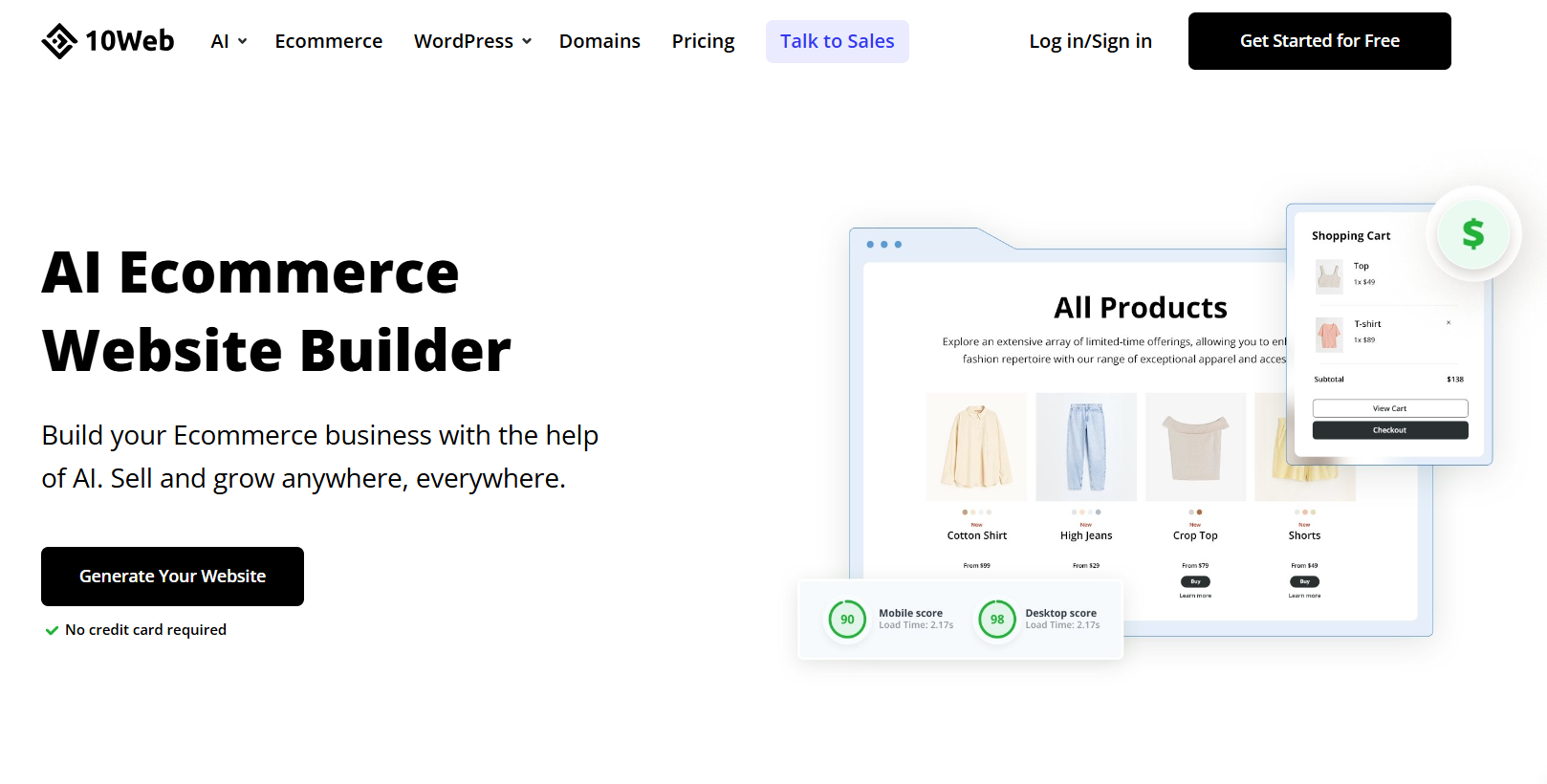
We like 10Web for its user-friendly interface and fast setup process. It’s great for small businesses that want to get online quickly. The platform also includes hosting and security features, so you don’t need to worry about those separately.
On the downside, 10Web has fewer advanced ecommerce features compared to some specialized platforms. You may find it limiting if you need complex inventory management or shipping options.
Pricing for 10Web starts at around $11 per month for basic ecommerce features. Higher tiers offer more storage and advanced tools.
| Pros | Cons |
| Easy to use | Limited advanced features |
| WordPress integration | May outgrow as business expands |
| Includes hosting | Some features cost extra |
We chose 10Web because it’s a good all-in-one solution for small businesses new to online selling. It’s best for entrepreneurs and small shops that want an easy way to start selling online without a steep learning curve.

Create your online store in minutes!
Looking to sell online? Develop and launch your store with 10Web AI Ecommerce Website Builder.
2. Shopify
Shopify is a popular ecommerce platform that lets you create an online store. It offers tools to help you sell products, manage inventory, and process payments.
You can choose from many design templates to customize your store’s look. Shopify also provides apps to add extra features like marketing tools or customer reviews.

Many users like Shopify’s ease of use and all-in-one approach. It handles hosting, security, and updates for you. The platform works well for both new and experienced sellers.
Some downsides include transaction fees if you don’t use Shopify Payments. The monthly costs can add up, especially for larger stores. You may need to pay for apps to get certain features.
Shopify’s plans start at $29 per month and go up to $299 for advanced features. There’s also a Shopify Plus option for big businesses.
| Pros | Cons |
| Easy to use | Transaction fees for some payment methods |
| Many design options | Can get expensive with add-ons |
| Built-in tools for selling | Some features require paid apps |
We picked Shopify as a top choice because it’s user-friendly and scalable. It works for many types of businesses, from small startups to large companies.
Shopify fits best for people who want an easy way to start selling online. It’s good for those who don’t have much tech experience but want a professional-looking store.
3. Bigcommerce
BigCommerce is a popular B2C ecommerce platform that offers a range of features for online stores. You can build and manage your website, process payments, and handle shipping all in one place. The platform is known for its flexibility and scalability.
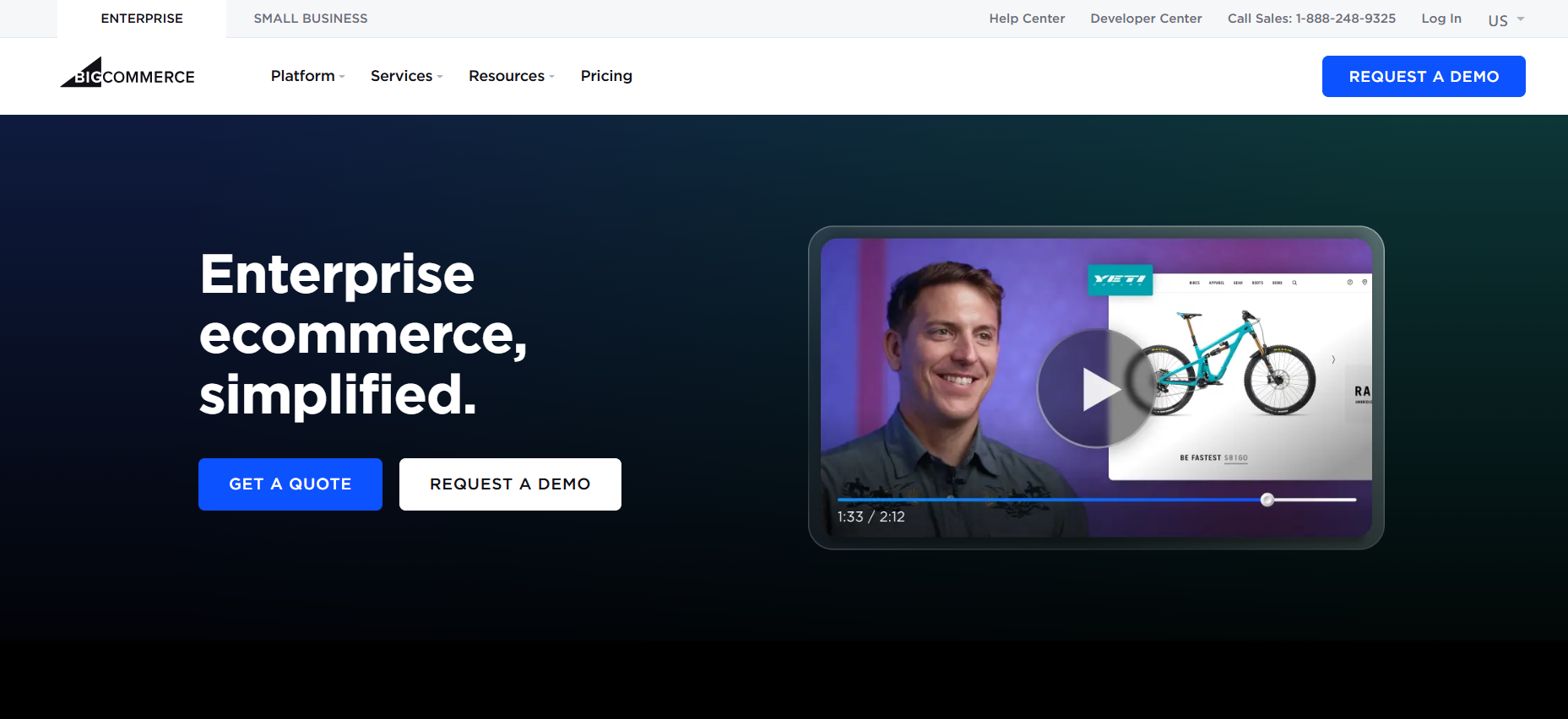
BigCommerce provides many built-in tools to help you grow your business. You can easily add product variations, set up discounts, and manage inventory. The platform also integrates with many third-party apps and services to extend its capabilities.
One standout feature is BigCommerce’s strong SEO tools. These help your products show up better in search results. The platform also offers multi-channel selling options, letting you list products on marketplaces like Amazon and eBay.
| Pros | Cons |
| Easy to use interface | Can be pricey for larger stores |
| Strong SEO features | Limited free themes |
| Lots of built-in sales tools | Some advanced features require coding |
BigCommerce plans start at $29.95 per month for basic features. More advanced plans cost up to $299.95 per month. Custom enterprise pricing is also available for large businesses.
We chose BigCommerce for its balance of features and ease of use. It’s a good fit for growing businesses that need a scalable platform. The strong SEO tools and multi-channel selling options make it especially useful for brands looking to expand their online presence.
4. Magento
Magento, now known as Adobe Commerce, is an ecommerce platform for businesses of all sizes. It offers a wide range of features to create and manage online stores for both B2C and B2B customers.
You can use Magento to build custom storefronts tailored to your brand. The platform allows you to manage multiple stores from one backend, making it easier to run different websites for various markets or product lines.
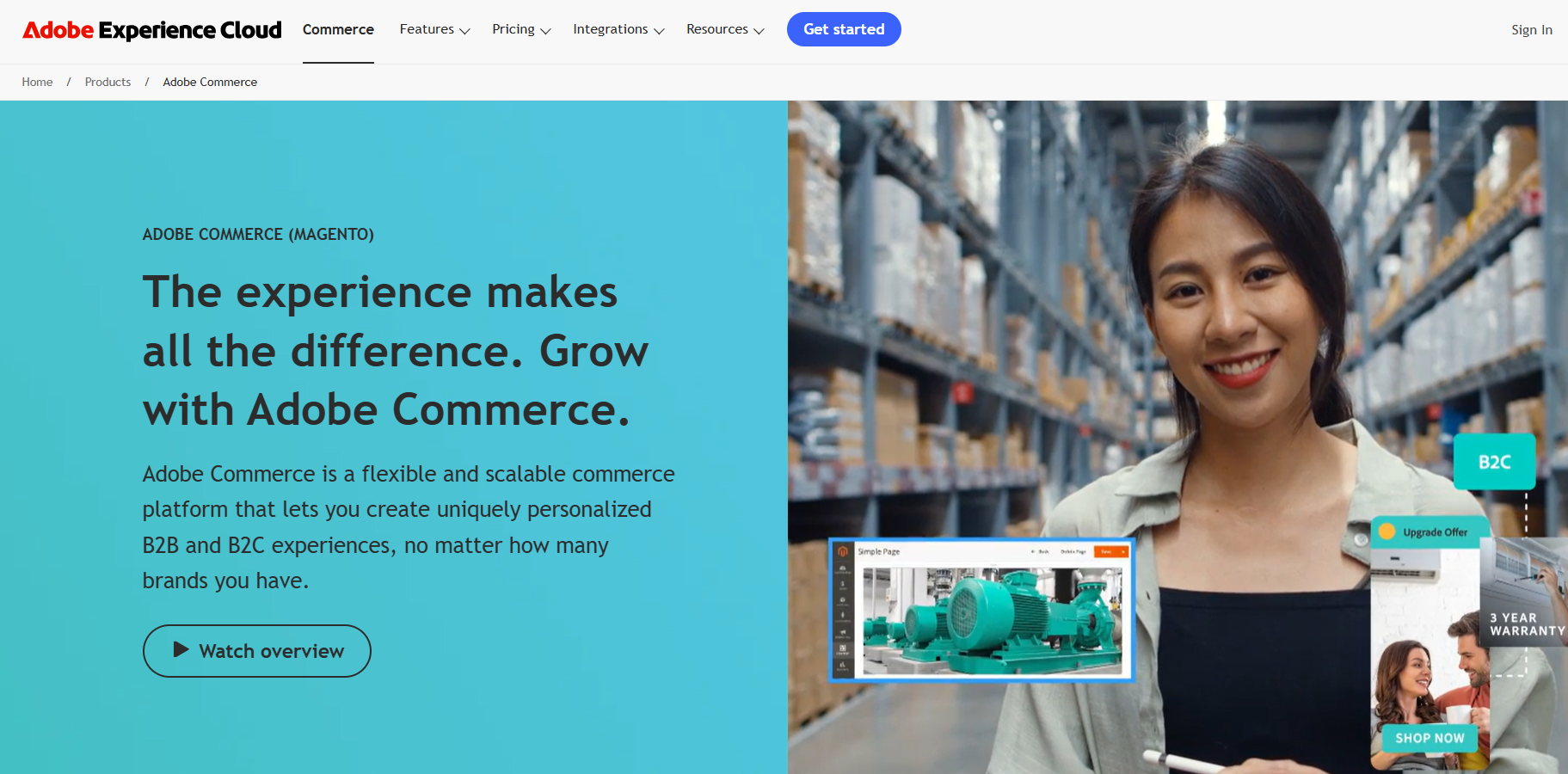
Magento provides tools for product management, order processing, and customer engagement. You can set up complex pricing rules, run promotions, and offer personalized shopping experiences.
One of the platform’s strengths is its flexibility. You can extend its functionality through a large ecosystem of extensions and integrations. This allows you to add features like advanced search or inventory management as your business grows.
| Pros | Cons |
| Highly customizable | Can be complex to set up |
| Scalable for growing businesses | Requires technical expertise |
| Strong B2B capabilities | Can be expensive for small businesses |
Magento’s pricing varies based on the version and your specific needs. The open-source Community Edition is free, while the Enterprise Edition can cost thousands per year.
We chose Magento for its versatility and ability to handle complex ecommerce needs. It’s best suited for medium to large businesses that need a highly customizable platform and have the resources to manage it effectively.
5. Squarespace
Squarespace is a popular B2C ecommerce platform known for its sleek design templates and user-friendly interface. You can create stunning online stores without coding skills. The platform offers a range of features to help you sell products and services.
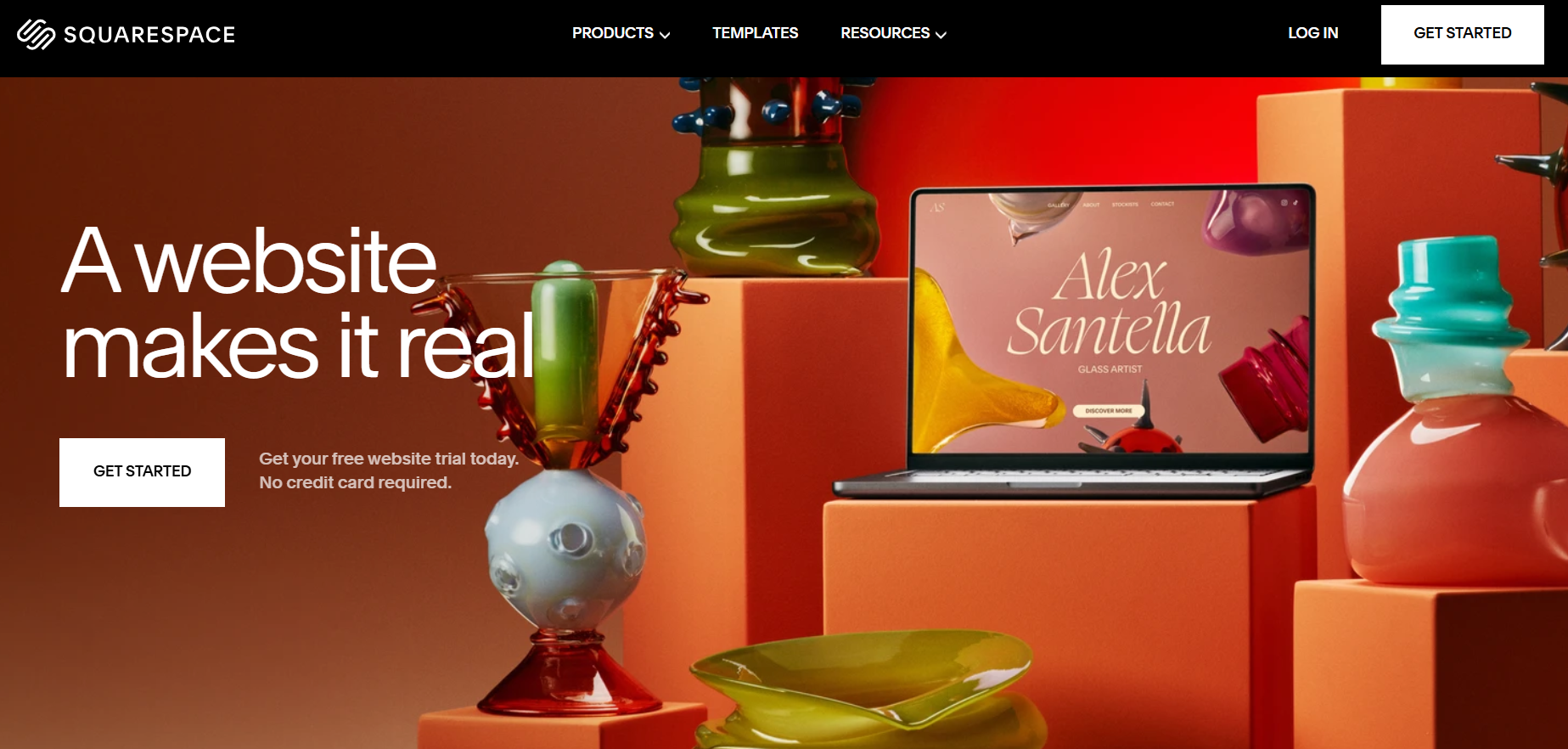
Squarespace provides tools for inventory management, order tracking, and shipping integration. You can easily set up product pages with high-quality images and detailed descriptions. The platform also supports digital downloads for selling virtual goods.
One of the main advantages of Squarespace is its beautiful, mobile-responsive templates. Your store will look great on all devices. The platform also includes built-in marketing tools like email campaigns and social media integration.
On the downside, Squarespace has fewer app integrations compared to some competitors. This may limit your options for advanced features or third-party tools. The platform also charges transaction fees on its lower-tier plans, which can impact your profits.
Squarespace offers plans ranging from $16 to $54 per month for online stores. The higher-tier plans remove transaction fees and add more advanced commerce features.
| Pros | Cons |
| Beautiful design templates | Limited app integrations |
| User-friendly interface | Transaction fees on lower-tier plans |
| Built-in marketing tools | Less customization options |
Squarespace is best for small businesses and creatives who want a visually appealing online store without complex setup. It’s ideal if you value design and ease of use over advanced features.
Successful B2C ecommerce website features
Good B2C ecommerce websites share some key traits. They make shopping easy and work well on phones. These features help turn visitors into buyers.
User experience and navigation
A great b2c website is simple to use. The menu should be clear and help you find products fast. Search tools let you quickly locate items. Product pages need big photos and full details. The checkout process must be quick and easy.
Clear categories help you browse. Filters narrow down choices based on things like price or color. Product recommendations show you related items you might like. Reviews from other buyers give you more info to decide.
A wishlist lets you save items for later. Your cart should be easy to see and edit as you shop. Guest checkout is good for new customers who don’t want to make an account yet.
Mobile optimization
More people shop on phones now. B2C sites need to work well on small screens. Text should be big enough to read. Buttons must be easy to tap with your finger.
The site should load fast on mobile data. Images need to resize for phones. Forms should be short and use the right mobile keyboard. One-click buying makes checkout quick on a small screen.
A responsive design fits any screen size. The menu should be easy to use on phones. Product photos should zoom smoothly on mobile. The whole site needs to work just as well as on a computer.

Create your online store in minutes!
Looking to sell online? Develop and launch your store with 10Web AI Ecommerce Website Builder.
Best B2C ecommerce website examples
The best B2C ecommerce websites offer smooth shopping experiences and helpful features. Let’s explore a few standout examples to see what sets them apart from the competition.
Nike
Nike‘s online store offers a clean, user-friendly design that puts products front and center. You’ll find a simple navigation menu at the top, making it easy to browse different categories.
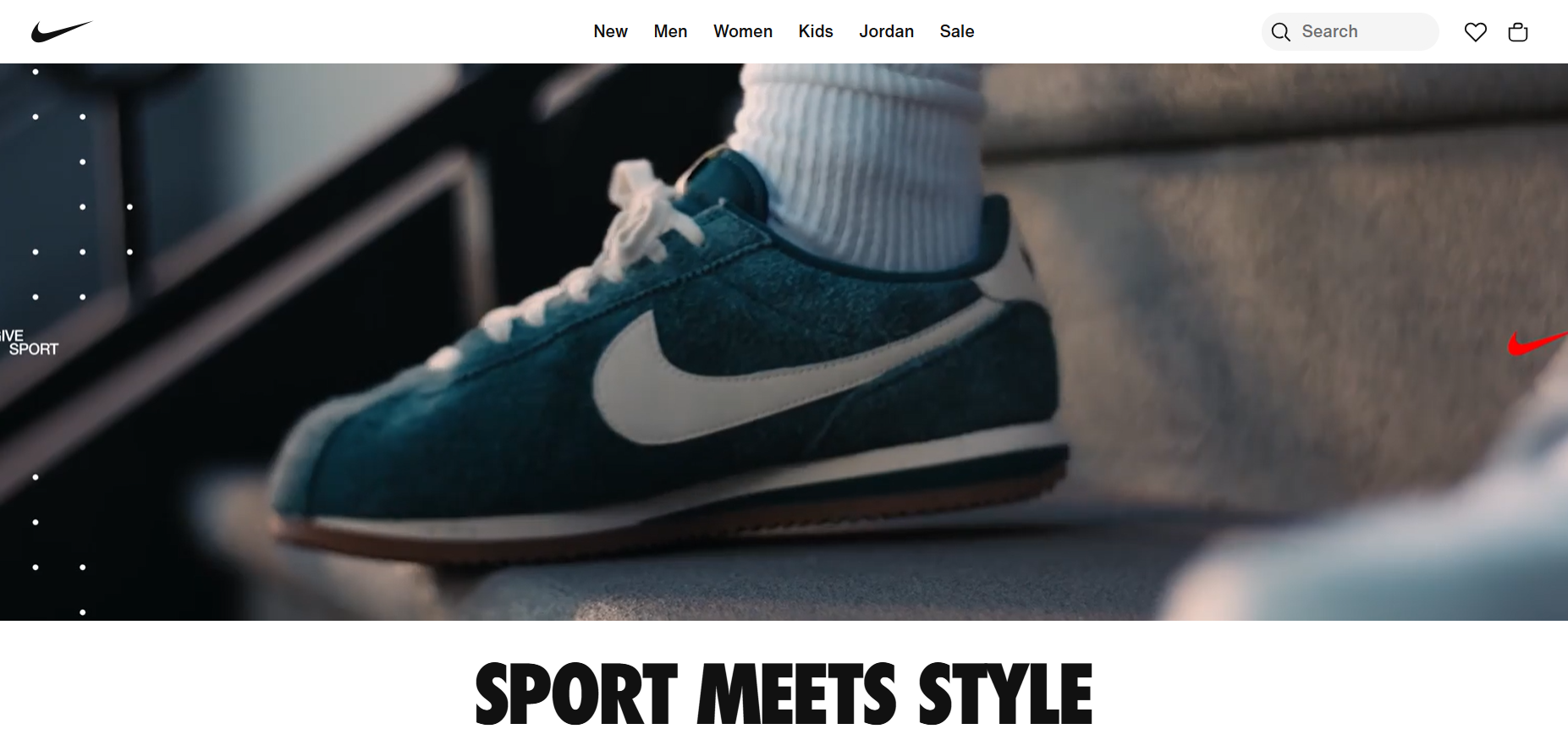
The site uses high-quality product images and videos to showcase items. This helps you get a better feel for how shoes and clothing look before buying. Nike also includes customer reviews, which can help you make informed decisions.
One of Nike’s strengths is personalization. The site remembers your preferences and suggests products you might like. You can also customize certain shoes, adding your own touch to your purchase.
Nike’s mobile experience is smooth and responsive. You can shop easily on your phone or tablet, with all the same features as the desktop site.
The brand offers free shipping for Nike members, which is a nice perk. Returns are also free within 60 days, giving you peace of mind with your purchases.
Zulu Longines
Zulu Longines offers luxury watches with a focus on aviation-inspired designs. The brand combines Swiss watchmaking traditions with modern aesthetics.
You’ll find a range of timepieces from classic pilot watches to sleek dress models. Zulu Longines prides itself on attention to detail and quality craftsmanship.

The company’s website showcases their products with high-resolution images and detailed descriptions. You can easily browse different collections and filter by features like case material or movement type.
One standout aspect is the virtual try-on feature. It lets you see how a watch looks on your wrist using augmented reality technology.
On the downside, the site’s navigation can be a bit confusing at first. Some users might find it takes time to locate specific information.
We chose Zulu Longines for their unique blend of aviation heritage and modern design. Their website does a good job of telling the brand’s story while showcasing products.
This brand is best for watch enthusiasts who appreciate aviation history and want a luxury timepiece with a story behind it.
Ketnipz
Ketnipz is a clothing and accessories brand that sells items with funny illustrations. The brand started as an Instagram comic created by Harry Hambley. You’ll find Bean, the main character, on products and even murals around the world.
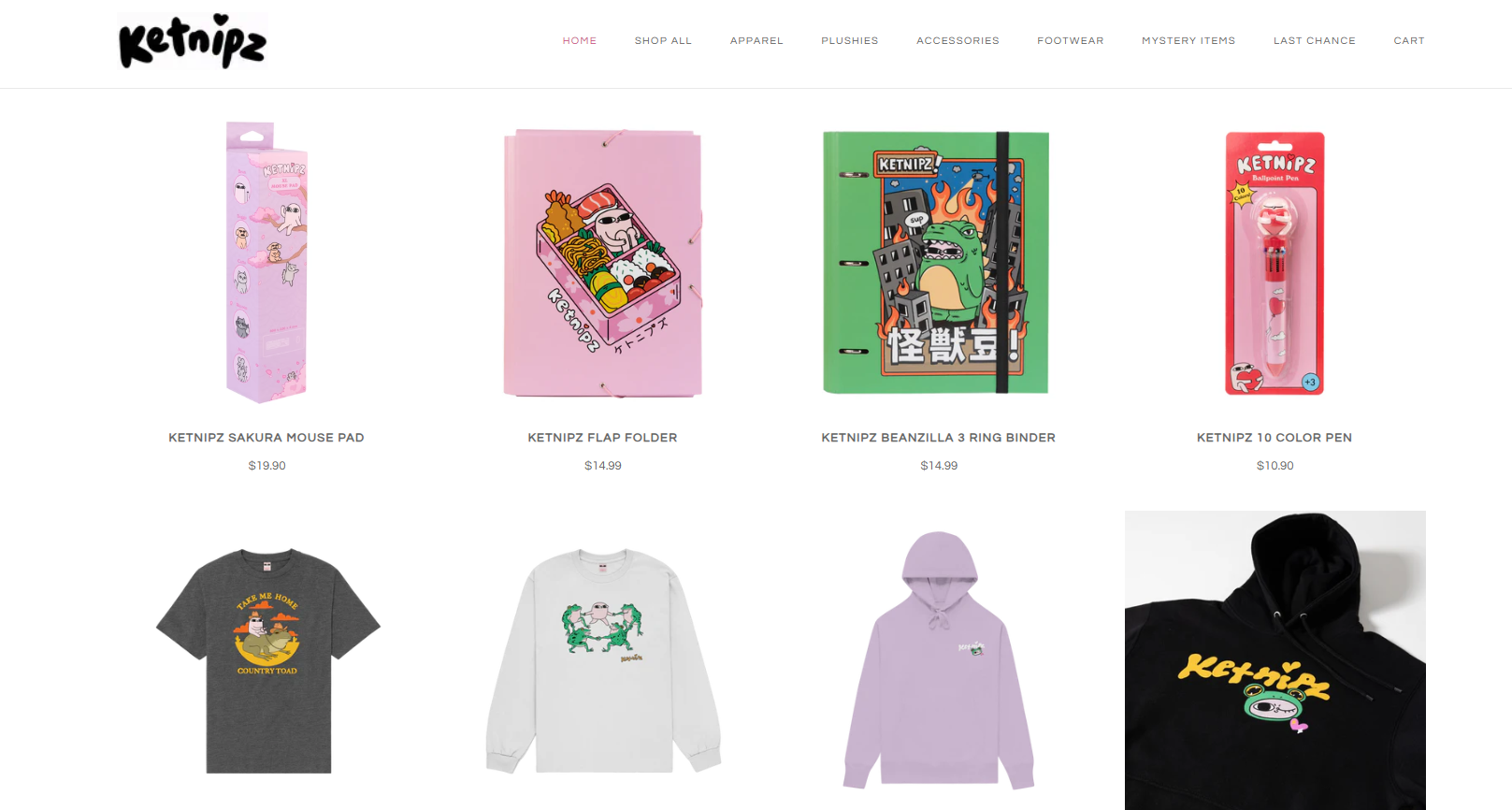
The Ketnipz website matches its playful brand identity perfectly. When you visit the homepage, you’re greeted by an animated illustration that sets a cheerful tone. The color palette aligns with the brand’s logo, creating a cohesive look.
You’ll love the vibrant and fun design that captures attention right away. The site invites you into a world of humor and positivity. It’s easy to navigate and find products you want.
One downside is that the animated elements might slow down loading times for some users. The site could also benefit from more detailed product descriptions.
We chose Ketnipz because it shows how a strong brand identity can translate into an engaging online store. The site turns visitors into customers by creating a fun shopping experience.
Ketnipz is best for people who enjoy quirky, lighthearted designs and want to express their personality through their clothing and accessories.
Pitch Tents
Pitch Tents offers luxury bell tent rentals for glamping adventures across the UK. You can enjoy stylish outdoor stays at festivals, weddings, and corporate events without the hassle of setup. The company takes care of everything, from putting up the tents to taking them down when you’re done.

When you book with Pitch Tents, you get more than just a place to sleep. Their bell tents are spacious and comfortable, giving you a taste of the outdoors with a touch of luxury. You don’t need to worry about bringing your own gear or figuring out how to set up camp.
One drawback is that Pitch Tents only serves the UK market. If you’re looking for glamping options in other countries, you’ll need to find a different provider. The service might also be pricier than traditional camping due to its luxury focus.
Prices vary based on event type and duration, but expect to pay more than you would for standard camping equipment rental. Pitch Tents stands out because it combines the appeal of camping with the comfort of a hotel room, all in a convenient package.
This service is perfect for anyone who wants to experience nature without sacrificing comfort. Whether you’re a festival-goer who doesn’t want to deal with tent poles or a couple planning an outdoor wedding, Pitch Tents can elevate your event.
Vitra
Vitra is a Swiss furniture company that offers stylish home and office furnishings. Their website showcases their product range in a visually appealing manner. The clean design and high-quality images highlight Vitra’s commitment to modern aesthetics.

You’ll appreciate Vitra’s user-friendly navigation. The site makes it easy to browse different product categories and find what you need. Their product pages provide detailed information and multiple images to help you make informed decisions.
One downside is that Vitra’s website can be slow to load at times. This might frustrate some users who want quick access to product information. The site also lacks a robust search function, which can make finding specific items challenging.
We chose Vitra for this list because of their stunning product presentation. The website does an excellent job of showcasing their designer furniture and creating a sense of luxury.
Vitra’s website is best for design enthusiasts and professionals looking for high-quality, modern furniture. It caters to those who value aesthetics and are willing to invest in premium pieces for their homes or offices.
Marketing and customer engagement
B2C ecommerce platforms need strong marketing and customer engagement strategies to succeed. These approaches help businesses connect with shoppers, build loyalty, and boost sales.
SEO best practices
Search engine optimization (SEO) is key for online stores. It helps them appear higher in search results and get more visitors. Good SEO starts with keyword research to find terms shoppers use. These keywords should be used in product titles, descriptions, and meta tags.
A clear site structure also matters for SEO. This means organizing products into logical categories and using descriptive URLs. Fast page loading speeds are important too. Slow sites can hurt search rankings and frustrate customers.
Content like blog posts and buying guides can improve SEO. These pages target relevant keywords and keep people on the site longer. They also give other sites a reason to link back, which boosts authority.
SEO is an ongoing process. Store owners should track their rankings and traffic. They can use this data to keep improving their optimization efforts over time.
Content marketing
Content marketing helps ecommerce businesses attract and keep customers. It involves creating useful content that shoppers want to read or watch. This can include how-to guides, product comparisons, and educational articles.
Good content answers customer questions and solves their problems. For example, a clothing store might share style tips or care instructions. A tech store could explain the differences between product features.
Videos are powerful for content marketing. They can show products in action or give detailed tutorials. Infographics work well to present complex information in a simple way.
User-generated content like reviews and photos can be very effective. It provides social proof and helps build trust with potential buyers. Encouraging customers to share their experiences can create a steady stream of fresh content.
Email marketing
Email marketing is a direct way to reach customers and drive sales. It starts with building an email list. Offering a discount for signing up is a common tactic. Pop-ups and landing pages can help collect email addresses too.
Personalization makes email marketing more effective. This means sending targeted messages based on customer behavior. For instance, a shopper who viewed winter coats might get an email about cold weather gear.
Automated email sequences can nurture leads and reduce cart abandonment. Welcome emails, post-purchase follow-ups, and re-engagement campaigns are all useful types. These keep the conversation going with customers at different stages.
Email design matters. Messages should look good on both desktop and mobile devices. Clear calls-to-action and eye-catching images help drive clicks and sales.
Social media integration
Social media helps B2C ecommerce platforms connect with customers. It’s a place to share products, respond to questions, and build brand awareness. Each platform has its strengths. Instagram and Pinterest are great for visual products. Twitter works well for customer service.
Social proof is powerful on these platforms. Showing real customers using products can inspire others to buy. User-generated content campaigns encourage shoppers to share their own photos and videos.
Social selling features let people buy directly through social media. This removes friction from the purchase process. It’s especially useful for impulse buys and limited-time offers.
Paid social ads can target specific audiences. This helps reach new potential customers who match existing buyer profiles. Retargeting ads remind people of products they’ve viewed but not purchased.
Loyalty programs and promotions
Loyalty programs reward repeat customers. They can offer points for purchases, exclusive discounts, or early access to new products. These perks encourage shoppers to keep coming back.
Tiered programs give bigger rewards to the best customers. This can motivate people to spend more to reach higher levels. Some programs partner with other brands to offer a wider range of benefits.
Promotions create urgency and drive sales. Limited-time offers work well for clearing out inventory. Flash sales can generate excitement and bring in new customers.
Seasonal promotions tie into holidays and events. Back-to-school sales and holiday gift guides are common examples. These campaigns should be planned well in advance to maximize their impact.
Referral programs turn happy customers into brand advocates. Offering rewards for bringing in new shoppers can be a cost-effective way to grow. Both the referrer and the new customer often get a benefit, creating a win-win situation.

Create your online store in minutes!
Looking to sell online? Develop and launch your store with 10Web AI Ecommerce Website Builder.
Future trends in B2C ecommerce
The B2C ecommerce landscape is evolving rapidly, driven by technological advancements and changing consumer behaviors. New trends are shaping how online businesses interact with customers and conduct sales.
Mobile commerce growth
Mobile devices are becoming the primary way people shop online. More consumers use smartphones and tablets to browse products, compare prices, and make purchases. This shift has pushed businesses to create mobile-friendly websites and apps.
Many companies now use responsive design to ensure their sites work well on all screen sizes. Some have developed dedicated mobile apps with features like push notifications and one-click ordering.
Mobile wallets like Apple Pay and Google Pay are gaining popularity. These allow for quick, secure payments without entering card details each time.
Voice shopping through smart speakers is also on the rise. Customers can order items by speaking to devices like Amazon Echo or Google Home.
Artificial intelligence and personalization
AI is transforming how online stores understand and serve their customers. Machine learning algorithms analyze vast amounts of data to predict shopping habits and preferences.
This allows for highly personalized product recommendations. Shoppers see items they’re more likely to buy, improving conversion rates.
Chatbots powered by AI provide 24/7 customer support. They can answer questions, track orders, and even help with product selection.
Visual search is another AI-powered trend. Customers can upload images to find similar products, making discovery easier.
Predictive analytics help businesses forecast demand and manage inventory more efficiently. This leads to fewer stockouts and better customer satisfaction.
Social commerce expansion
Social media platforms are becoming important sales channels. Many now offer built-in shopping features that let users buy products without leaving the app.
Instagram Shopping and Facebook Marketplace are examples of this trend. They allow businesses to tag products in posts and stories, creating seamless shopping experiences.
Live streaming commerce is growing fast, especially in Asia. Influencers showcase products in real-time video broadcasts, often with special deals for viewers.
User-generated content like reviews and photos plays a big role in social commerce. It builds trust and helps shoppers make informed decisions.
Brands are also using social media for customer service. Quick responses to comments and messages improve customer satisfaction and loyalty.
Sustainability in ecommerce
Eco-friendly practices are becoming more important to consumers. Many shoppers now consider a company’s environmental impact when making purchases.
Online retailers are responding by using more sustainable packaging. This includes recyclable materials and right-sized boxes to reduce waste.
Some businesses offer carbon-neutral shipping options. They invest in projects that offset the emissions from delivery vehicles.
Resale and second-hand marketplaces are growing. Platforms like ThredUp and Poshmark let people buy and sell used items, reducing waste.
Many brands now highlight their sustainable practices on product pages. This transparency helps eco-conscious shoppers make informed choices.
Cross-border ecommerce developments
Global online shopping is becoming easier and more common. Improvements in logistics and payment systems are breaking down international barriers.
Many ecommerce platforms now offer built-in translation and currency conversion. This makes it simple for businesses to sell to customers worldwide.
International shipping options are expanding. Services like DHL ecommerce and FedEx Cross Border offer specialized solutions for online retailers.
Payment providers are making cross-border transactions smoother. Services like PayPal and Stripe handle currency conversions and local payment methods.
Some countries are creating special economic zones for cross-border ecommerce. These offer tax benefits and simplified customs procedures for online sales.
Conclusion
In today’s digital-first economy, B2C ecommerce platforms are essential for businesses aiming to thrive in online retail. Offering tools for store management, secure payments, and mobile-friendly experiences, these platforms create seamless shopping journeys that meet customer expectations.
Choosing the right platform requires aligning features with business needs and future growth goals. With the right B2C ecommerce solution, businesses can deliver engaging, personalized experiences that foster customer loyalty and support scalable growth. As trends like AI personalization and mobile commerce continue to shape the landscape, a well-selected platform positions businesses to thrive in the evolving world of online retail.









